Introductory remarks: Mesozoic Foraminifera (The Jurassic Forams)
Similar to the Triassic Period, the Jurassic followed a marked episode of mass extinction in the marine realm at the end of the Triassic, however. This
extinction event affected all groups of larger benthic foraminifera (BouDagher-Fadel, 2008). The total extinction of the Fusulinoidea was significant as it had survived the much greater Permian extinction but were completely and forever wiped out at the end of the Triassic.Smaller forms of the Textulariina, Involutinina and Miliolina suborders surved, however, only the agglutinated textulariines showed any important evolutionary developments during the Jurassic (BouDagher-Fadel, 2008). The Paleozoic forams had aragonitic/calcareous microgranular walls but during the Jurassic, these were replaced by calcareous walls bonded by organic cement. Agglutinated forms developed large, internally complicated tests and many lineages were produced during the Jurassic.
The Jurassic benthic foraminifera have been systematically studied and classified by many researchers. Please refer to Chapter 4 of BouDagher-Fadel (2008),
Dr. Marcelle K. BouDagher-Fadel of the University College of London (
University College of London - MIRACLE) from which this page is summarized, for a discussion on the many various authors and regions of the world from which Jurassic benthic foraminifera have been described.
BouDagher-Fadel (2008) presents a comprehensive revision of the taxonomy of the main genera of the Jurassic larger foraminifera, their evolutionary lineages and phylogenetic relationships, biostratigraphic ages and paleoenvironmental interpretations.
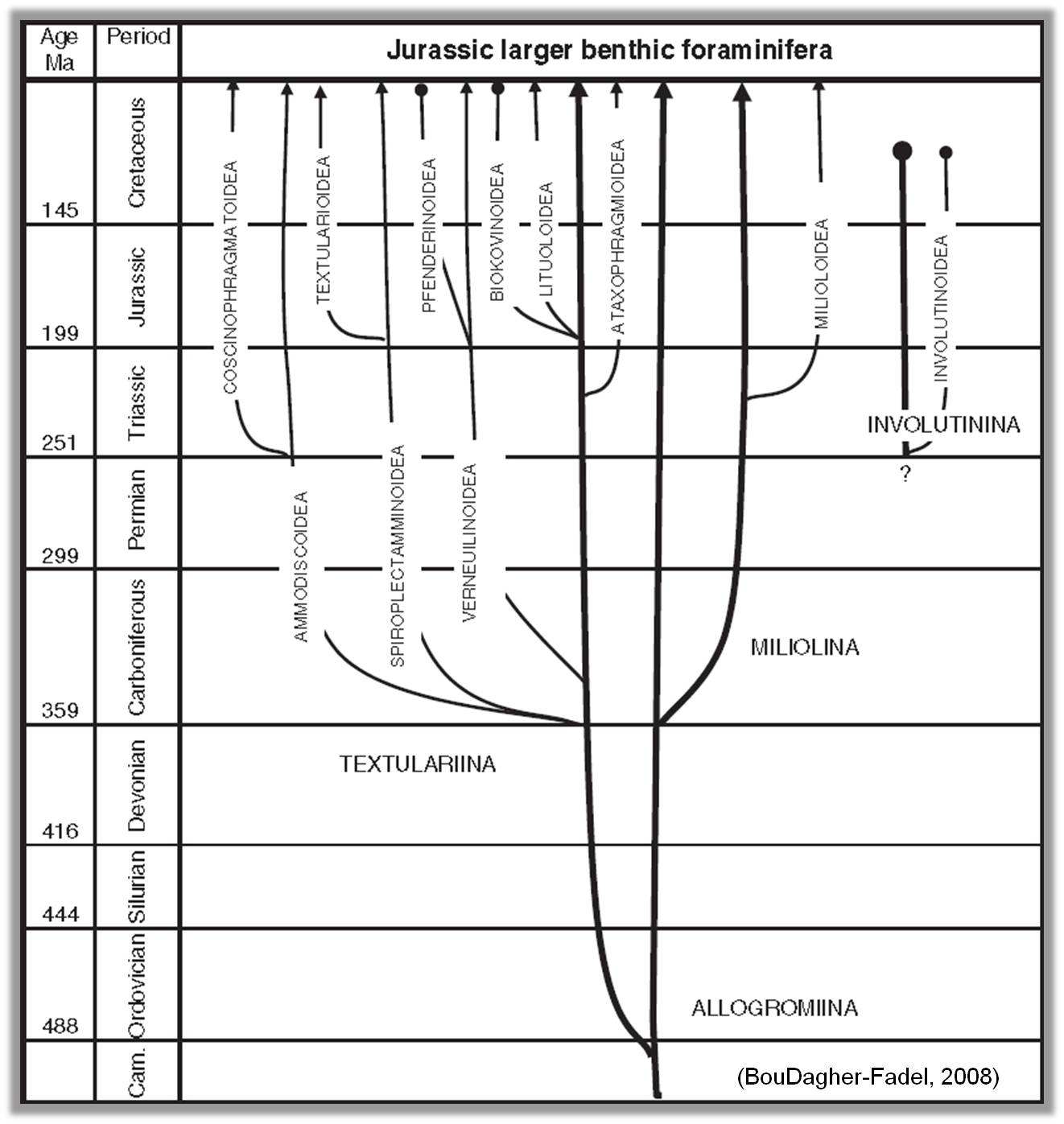
The dominant larger foraminifera of the Jurassic were the agglutinated Textulariina, Involutinina and the Miliolina, which were present but morphologically smaller. While the Lagenina were present, they were small and simple throughout the Jurassic. The figure to the left depicts the development and evolution of the Jurassic suborders (thick lines) and superfamilies (thin lines) of the larger benthic foraminifera.
SUBORDER INVOLUTININA
- Test: enrolled second chamber
- Wall: aragonitic but commonly recrystallized to give a homogenous microgranular structure; umbilical region with pillar-like stuctures on one or both sides of the test
- Geologic range: Early Permian to Late Cretaceous
Superfamily INVOLUTINOIDEA
- Test: consisting of a first chamber followed by a planispiral to trochospiral enrolled tubular second chamber
- Geologic range: Early Permian to Late Cretaceous
Family Involutinidae
- Test: globular proloculus followed by a trochospiral, coiled tubular second chamber. Secondary lamellar thickenings on one or both umbilical regions.
- Aperture: at the open end of the tube
- Geologic range: Late Triassic to Late Cretaceous
![]() 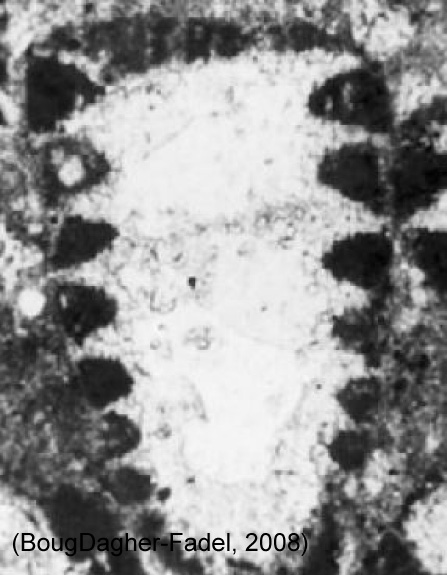 |
Andersenolina
Test:may be lenticular and conical in shape. The spherical proloculus is followed by a tubular, trochospiral second chamber.The umbilical side is covered by perforated lamellae added with each whorl and surrounded by small rounded margins. A primary aperture is absent.
Geologic range: Middle Jurassic to Early Cretaceous
|
![]() 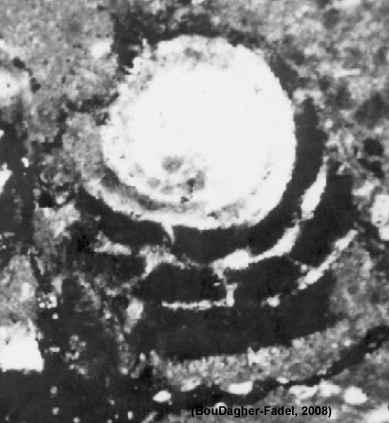 |
Septatrocholina (new genus)
Test: conical, consisting of a globular proloculus followed by a trochospirally enrolled divided tubular second chamber with rudimentary septa around a solid core of pillars filling the umbilical area.
Geologic range: Jurassic
|
Other significant genera include Involutina, Neotrocholina, and Trocholina. The figure below outlines the phylogenetic development of the Involutinoidea through the Jurrassic.
Involutinoidea: phylogenetic development through the Jurassic (after BouDagher-Fadel, 2008)
SUBORDER TEXTULARIINA
- Test: made of foreign particles bound by organic cement
- Geologic range: Early Cambrian to Holocene
Superfamily VERNEUILINOIDEA
- Test: trochospiral early, triserial of biserial, and later uniserial
- Wall: non-canaliculate
- Geologic range: late Carboniferous to Holocene
Family Verneuilinidae
- Test: biserial tests in early stages. Chambers are globular with a terminal aperture
![]()  |
Duotaxis
Test: reassigned from the Tetrataxinae family to the Verneuilinidae family. Has an early triangular stage and lacks a truly valvular tooth
Geologic range: Triassic to Early Jurassic
|
Superfamily PFENDERINOIDEA
- Test: trochospiral throughout, or one that may become uncoiled. Some forms have a siphonal canal, others develop a central composite columella with pillars between apertural plates and septa
- Geologic range: Early Jurassic to Cretaceous
Family Pfenderenida
- Test: loose trochospiral with siphonal canals that connect successive apertures in primitive forms. Some forms develop a central composite columella composed of thickened innermost septal ends (‘‘septal buttons’’) with or without additional pillars and a spiral canal between the columella and the thickened septa. A subcameral tunnel (simple or multiple) is present in advanced forms. The chamber interior of advanced taxa is subdivided by vertical or horizontal (or both) exoskeletal partitions, resulting in a reticulate subepidermal layer.
- Aperture: always cribrate, areal
- Geologic range: Early Jurassic to Late Cretaceous
Subfamily Pseudopfenderininae
- Test: trochospirally coilded throughout with no subcameral tunnel. middle of test has siphonal canal or is filled with columella made by interseptal pilllars and calcitic infilled material.
- Geologic range: Early Jurassic to Late Cretaceous
![]() 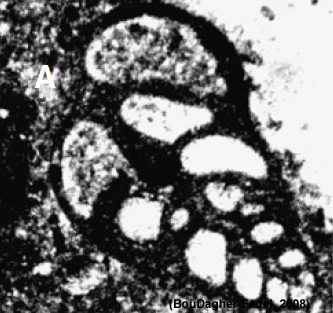 |
Test: trochospirally coiled (high or low) in general with three chambers per whorl; the test wall is canaliculate, but rarely visible as such; interior of chambers free; a twisted siphonal canal connects successive apertures; the aperture is unique, interiomarginal, but may become cribrate in the last chambers of advanced forms
Geologic range: Early Jurassic to Early Cretaceous
|
![]() 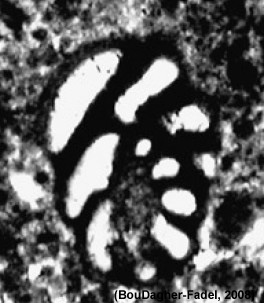 |
Test: high trochospiral with numerous
chambers. The umbilical part of the chamber interior is filled with numerous pillars that are continuous from chamber to chamber
Geologic range: Early Jurassic
|
Subfamily Palaeopfenderininae
- Test: may be uncoiled with various shapes; a simple or multiple spiral subcameral canal may be present and pillars between apertural plates and septa have calcitic filling giving the appearance of a columella.
- Aperture: terminal and multiple in the apertural plate
- Geologic range: Jurassic
- Genera: Conicopfenderina, Chablaisia, Palaeopfenderina, Pseudoeggerella, Sanderella, Satorina, Steinekella
Subfamily Pfenderininae
- Test: a single subcameral tunnel, always buried in the columella, formed by pillars and caclitic deposits. Aperture: multiple, cribrate and on the apertural plate
- Geologic range: Early Cretaceous
- Genera: Pfenderella, Pfenerina
Subfamily Kurbininae
- Test: without a subcameral tunnel and may not have a solid core; peripheral zone is divided by radial partitions
![]() 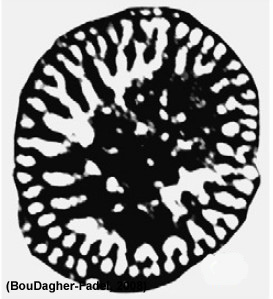 |
Conicokurnubia
Test: conical. with vertical partitions joining the center of the chambers and coalescing with the pillars Aperture: multiple, cribrate
Geologic range: Jurassic
|
![]() 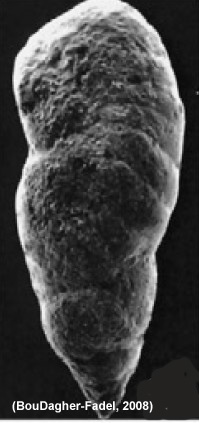 |
Kurnubia
Test: conical, cylindrical or elongate fusiform, consisting of chambers arranged in an elongate trochoid spiral. Inner surfaces of individual chambers marked off into chamberlets Aperture: represented by a number of closely set pores on the base of the test
|
Family Valvulinidae
- Test: trochospirally coiled an generally triserial in the early stage
- Wall: microgranular and may be alveolar with simple chamber interior
- Aperture: interiomarginal with a large valvular tooth. This family shows the first known example of a crosswise-oblique stolon system among the Pfenderinoidea. Stolons appear as a morphological convergence in different groups of lituoloids (valvulinids, orbitolinids, reniform-discoidal lituoloids)
Subfamily Valvulininae
- Test: includes forms with a simple or complicated valvular tooth plate
- aperture: simple or cribrate
- Geologic range: Jurassic to Holocene
![]() 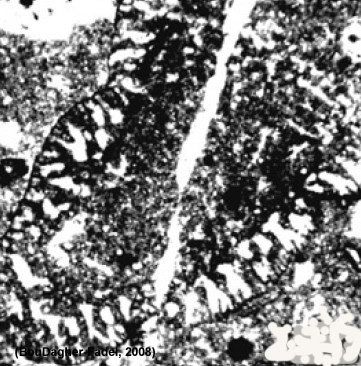 |
Test: conical, where the central zone septa thicken and coalesce into an almost solid mass. In some forms the later half of the test is formed by thin irregular plates intergrown by finer broadly spaced pillars. The early chambers are trochospiral. They coil along a vertical axis and occupy almost half the test, later they become rectilinear, with the outer parts of chamberlets subdivided by numerous pillars.
Geologic range: Jurassic to Holocene
|
![]() 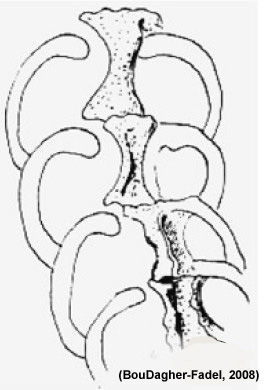 |
Test: trochospiral throughout, triserial. The valvular
tooth plate is simple or perforated by supplementary apertures. The primary
aperture is a basal slit
Geologic range: Jurassic to Holocene
|
Subfamily Parurgonininae
- Test: eight or more chambers per whorl with a valvular tooth plate complicated by pillars
- Aperture: multiple with a crosswise-oblique stolon system
- Geologic range: Late Jurassic
![]() 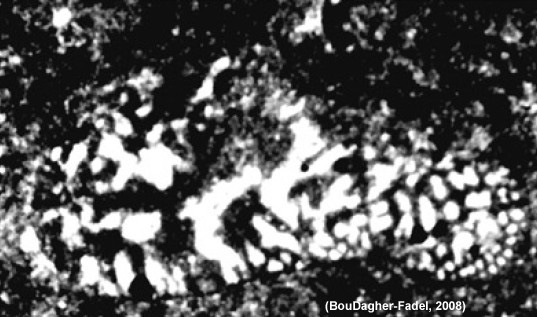 |
Test: highly conical test with numerous chamberlets, separated by curved septal extensions of the outer wall in a low trochospire.
Septa: break in the umbilical region to form subconical pillars
Geologic range: Jurassic
|
![]() 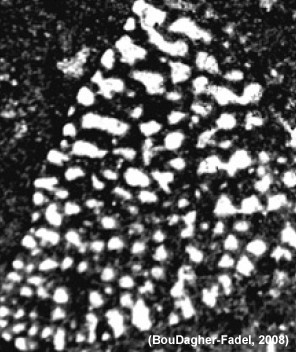 |
Test: The genus typically has 25 chambers per whorls in the adult stage as opposed to the Kilianina, which have 8. also, there is typically more pronounced development of pillars in the central part of the test
|
Superfamily LITUOLOIDEA
- Test: multilocular, rectilinear and uniserial with plani-strepto or trochospiral coiling in early stages. Radial partitions but centrally with our without scattered,separated pillars
- Aperture: simple or multiple, cribrate
- Geologic range: Jurassic to Holocene
Family Hauraniidae
- Test: uncoilded unserial or planispirally coiled
- Wall: microgranular with a hypodermic network
- Septa: simple or with complicated microstructure
- interior of chambers: simple or with pillars
- Aperture: multiple
- Geologic range: Jurassic
Subfamily Hauraniinae
- Test: uncoiled, uniserial or planispirally coiled
- Septa: simple or with complicated microstructure
- Interior of chambers: fine pillars in the central zone
- Geologic range: Jurassic
- Genera: Trochamijiella, Timidonella, Scootraina, Platyhaurania, Meyendorffina, Haurania, Gutnicella, Cymbriaella
![]() 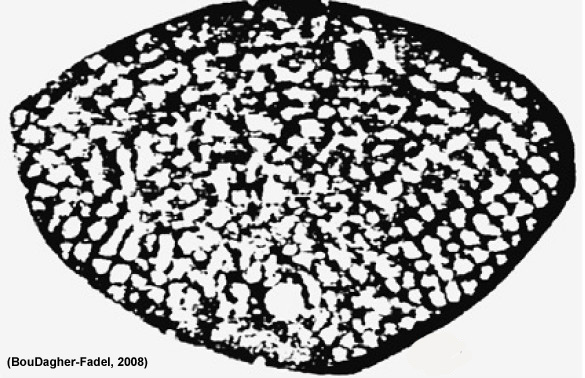 |
Gutnicella (formerly Lucasella)
Test: highly conical with a large spherical proloculus enclosed in early planispiral and involute coil. Later briefly trochospiral, then uniserial and rectilinear
Chambers: subdivided in the outer part by many short radial vertical partitions forming quadrate chamberlets (one row to each chamber). Central zone filled with irregular scattered separated pillars of all different sizes
|
![]() 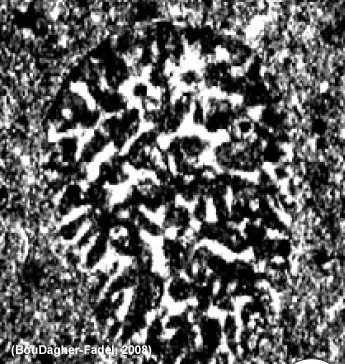 |
Test: delicate radial partitions often bifurcating vertically to form a partial tier of peripheral chamberlets.
Geologic range: Jurassic
|
![]() 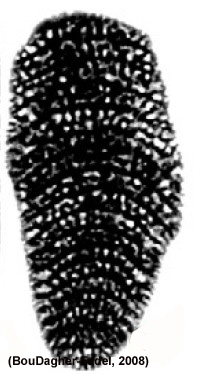 |
Test: non-canaliculate, septate, initially coiled
planispirally or in low trochospire. Uniserial chambers, filled with near-vertical, subradial partitions with a sinuous serpentine form. In the central areas of the
chambers the partitions fuse laterally.
Aperture: consists of many small pores between the partiions and is situated subterminally.
|
Subfamily Amijiellinae
- Test: uncoiled or planispirally coiled
- Septa: simple or have a complicated microstructure
- Interior of the chambers: simple but some genera may develop pillars; walls may have alveoles
- Aperture: multiple
- Geologic range: Jurassic to Cretaceous
- Genera: Alzonella, Alzonorbitopsella, Amijiella, Anchispirocyclina, Bostia, Dhrumella, Ijdranella, Kastamonina, Pseudospirocyclina, Spiraloconulus, Streptocyclammina
![]() 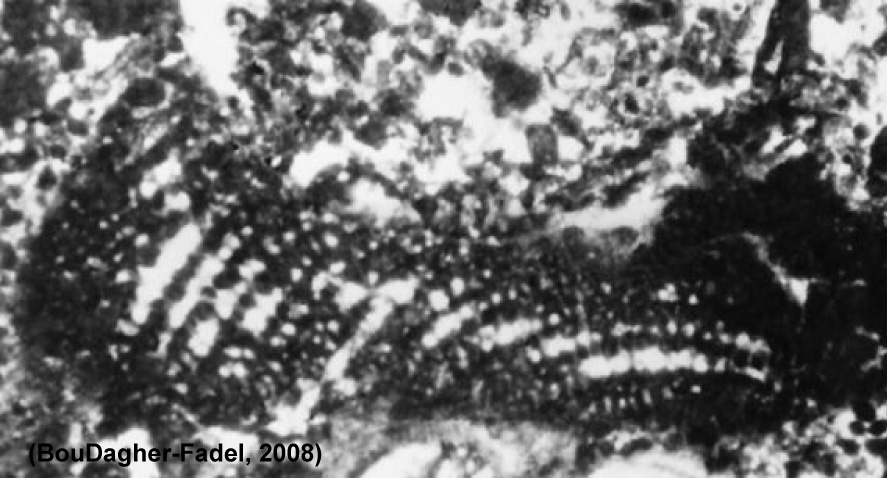 |
Test: planispiral with a hypodermis
consisting of a coarse lattice of beams and rafters.
Geologic range: Jurassic
|
![]() 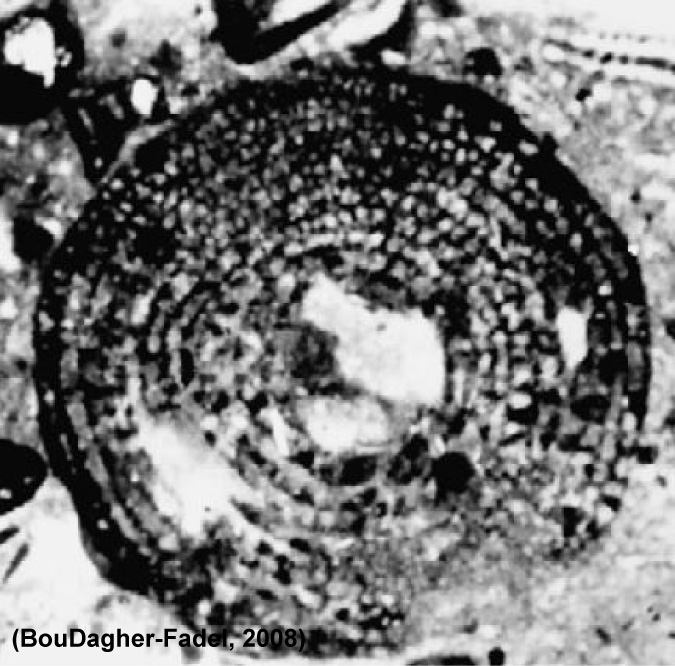 |
Test: planispiral, annular and discoidal with no
septulae.Subepidermal reticulate septa that are thickened around cribrate apertures, but lack true pillars linking septum to septum (i.e., Orbitopsella). Annualr chambers, immediately following the large megalospheric proloculus.
Geologic range: Jurassic
|
![]() 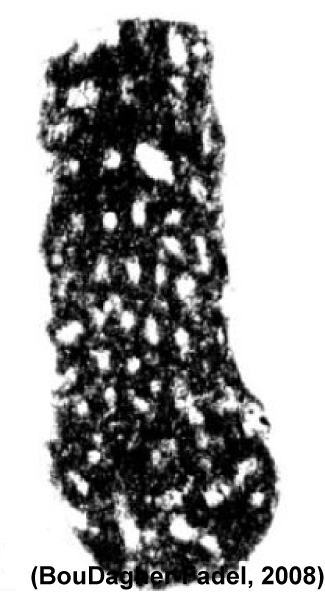 |
Test: straight and uniserial or planispiral to
uniserial in megalospheric generations. Radial partitions of chambers are srong and thicken towards the central zone (no pillars) Bifurcate vertically to form a few scattered chamberlets
Geologic range: Jurassic
|
![]() 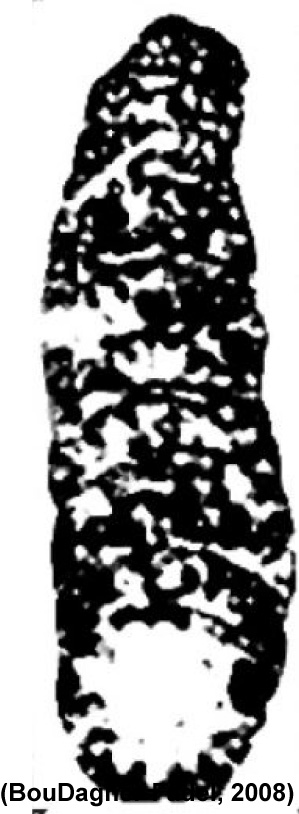 |
Test: dimorphic, with clearly distinct microspheric and megalospheric generations, characterised by a complicated embryonic apparatus and lack of pillars in the central zone.Subepidermal network formed by irregular radial and transverse partitions.
Geologic range: Jurassic
|
![]() 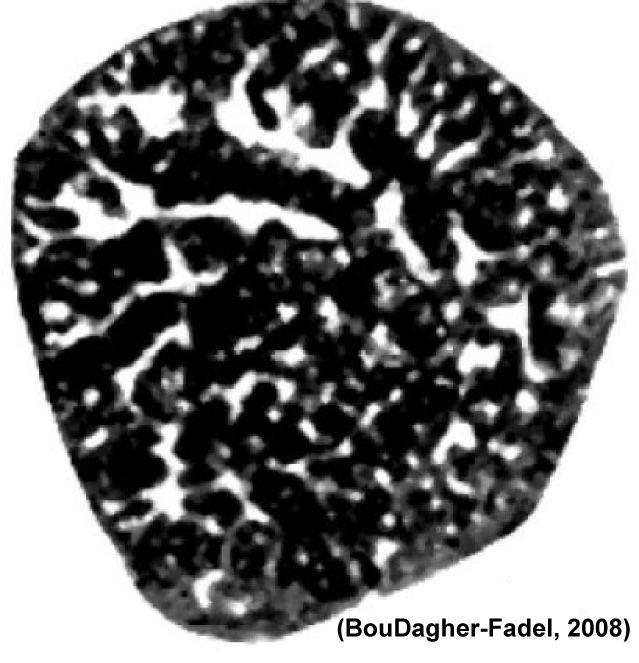 |
Test: A hauraniid with a compressed peneropliform
uncoiled stage and an exoskeleton containing long radial pillars superficially united by a coarse network.
Geologic range: Jurassic
|
Subfamily Choffatellinae
- Test: this subfamily possesses hypodermal alveoles and a planispiral test, however the early part may be streptospiral. Lacks continuously developed endoskeletal pillars
- Geologic range: Early Jurassic to Late Cretaceous
- Genera: Alveosepta,Choffatella, Palaeocyclammina, Pseudocyclammina, Redmondellina, Torinosuella
![]() 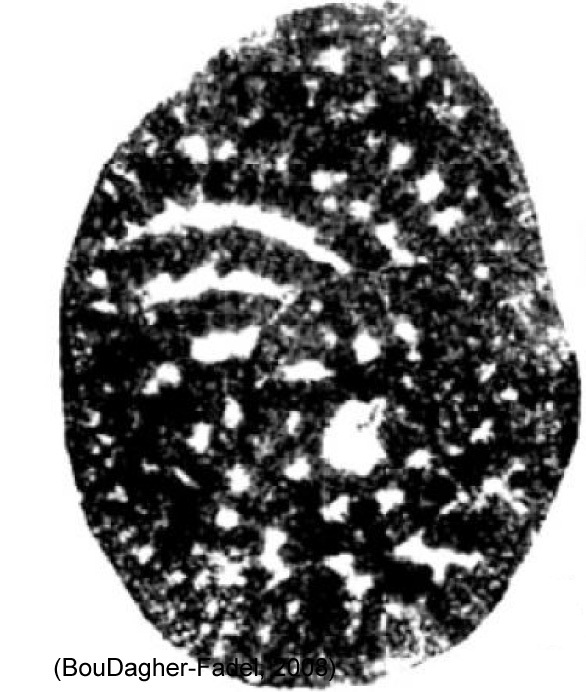 |
Test: planispiral, compressed and
involute with long low chambers. It differes from Pseudoclammina as it has a reticulate subepidermal skeleton comprised of an irregular superficial network made of short radial blades perpendicular to the septa
Geologic range: Early Jurassic
|
![]() 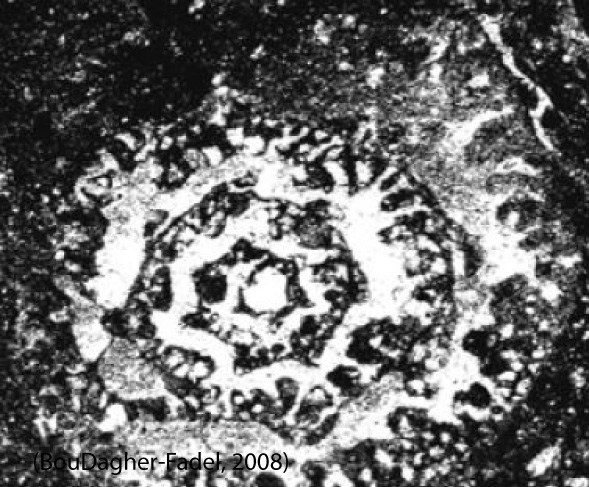 |
Test: planispiral nautiliform test, sometimes becoming uncoiled. The central zone of the test lacks the continuous endoskeletal pillars
Geologic range: Early Jurassic to Cretaceous
|
![]() 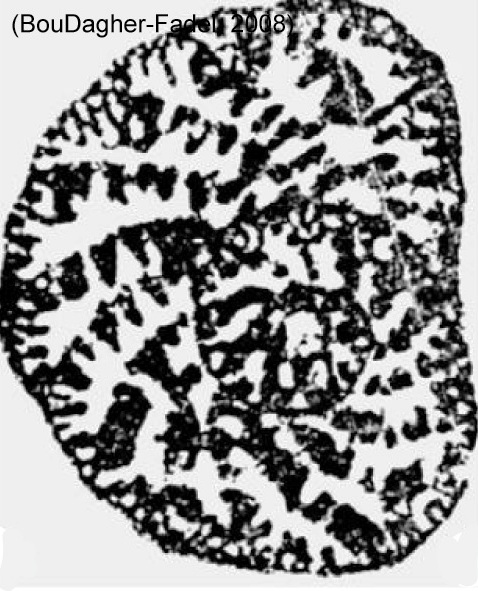 |
Test: compressed with pillar-like hypodermal extensions linking the septal hypodermis to the anterior of the epidermis of each preceding septum.
Geologic range: Late Jurassic
|
Family Everticyclamminidae
- Test: streptospiral or planisprial in early stages, uncoiled in the adult or uniserial throughout
- Walls: microgranular with an alveolar microstructure- interior chamber simple
- Aperture: unique and terminal
- Geologic range: Early Jurassic to Early Cretaceous
- Genera: Everticyclammina, Buccicrenata, Rectocyclammina
Family
Mesoendothyridae
- Test: strepto-or planispirally coiled, that has involute initial chambers and later is uncoiled. Adult chambers are cylindrical or flattened, falciform to cyclical, simple, with radial partitions or with pillars.
- Wall: microgranular to agglutinates, imperforate or alveolar, simple or with radial partitions, with or without pillars
- Aperture: a single slit or numerous pores
- Geologic range: Jurassic to Cretaceous
- Genera: Mesoendothyra
Subfamily Orbitopsellinae
- Test: early planispiral coiled followed by uniserial part in the adult becoming cylindrical. Alveolar microstructure wall. Interior of chambers are divided by vertical radial partitions and pillars in the central zone
- Geologic range: Early Jurassic
![]() 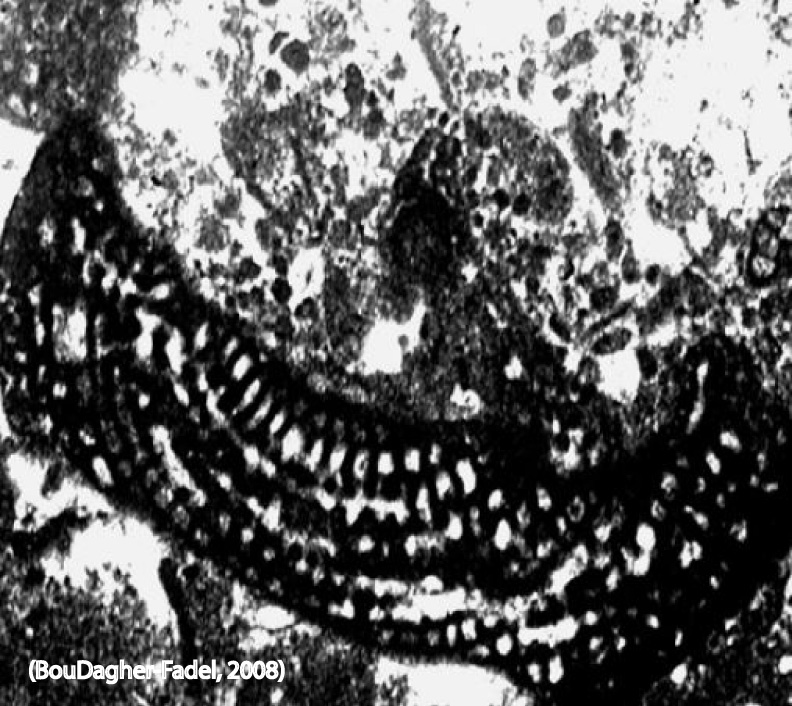 |
Test: An orbitopsellinine with adult chambers
becoming annular, pillars in the central zone and a cribrate aperture
Geologic range: Early Jurassic
|
![]() 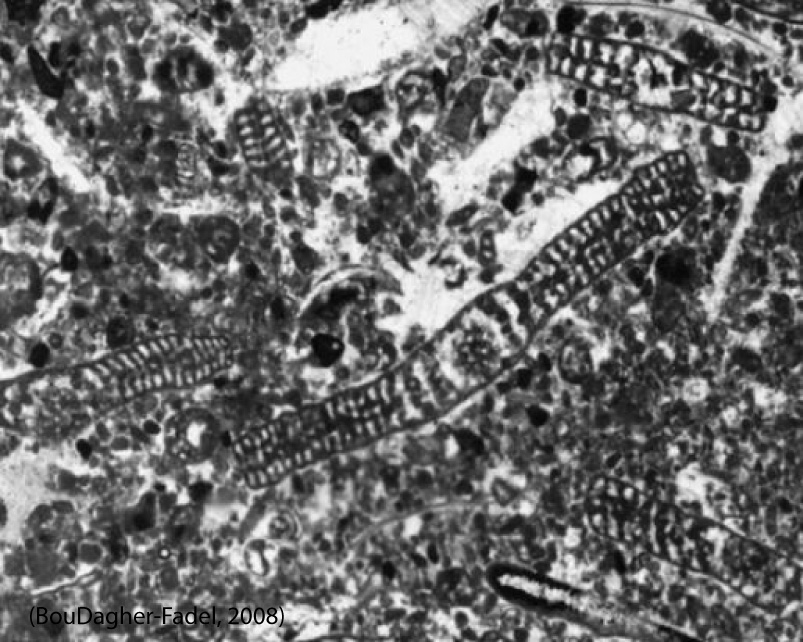 |
Test: orbitopsellinine with a discoidal test, the
first stage being planispiral followed by a flaring, flabelliform stage with 35 to 40 annular chambers. The wall has simple endoskeletal and exoskeletal pillars.
Geologic range: Early Jurassic
|
Subfamily Labyrinthininae
- Test: planispiral, compressed laterally and involute.
- Wall: microgranular with an alveolar microstructure.
- Interior of chambers: simple or with vertical partitions and
- pillars in the median layer.
- Aperture: multiple.
- Geologic range: Late Jurassic
- Genera: Labyrinthina
Subfamily Levantinellinae
- Test: Single layer of cyclical chambers, undivided by pillars
- Geologic range: Jurassic
- Genera: Levantinella, Syriana
Superfamily NEZZAZATOIDEA
- Test: trochospiral or planispiral, later occasionally uncoiled with a simple nonlamellar, microganular wall and may posses internal plates or simple partitions.
- Aperture: simple or multiple
- Geologic range: Cretaceous to Holocene
Family Maynicidae
- Test: biumbilicate or very compressed, planispirally enrolled, rarely uncoiling with simple, solid and microgranular wall.
- Chambers: increase rapidly in height with monolamellar septa
- Geologic range: Late Jurassic to Late Cretaceous
Superfamily BIOKOVINOIDEA
- Test: free with a trochospiral or plnaispiral early stage, later uncoiled with homogenous and massive septa.
- Aperture: basal to areal, single to multiple
- Geologic range: Early Jurassic to Late Cretaceous
Family Biokovinidae
- Test: planispirally coiled, later may uncoiled
- Walls: may contain alveoles that open both to exterior or interior
- Geologic Range: Early Jurassic
![]() 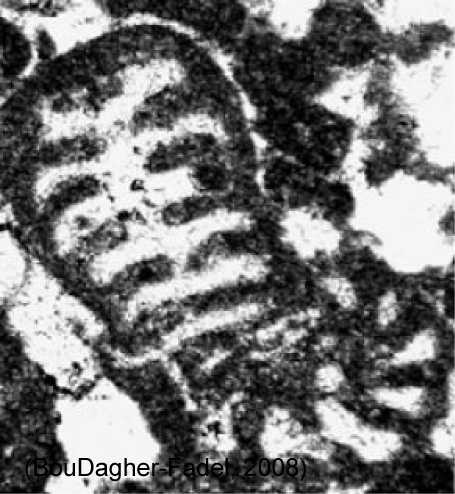 |
Test: well-developed uncoiled later stage with thick, widely spaced and gently curved septa
aperture: single in the coilded stage becoming cribrate in uncoiled part
Geologic range: Early Jurassic
|
Family Charentiidae
- Test: early stage planispiral or streptospiral
- Wall: finely canaliculated with single or multiple aperture
- Geologic range: Middle Jurassic to Late Cretaceous
- Genera: Karaisella
Family Lituoliporidae
- Test: planispirally coiled but later may be uncoiled
- Wall: with coarse alveoles
- Geologic range: Early Jurassic
Superfamily SPIROPLECTAMMINOIDEA
- Test: planispirally coiled or biserial in early stages, later biserial
- Wall: agglutinated, non-canaliculate
- Geologic range: Carboniferous to Holocene
Family Textulariopsidae
- Test: early biserial stage and later loosely biserial or uniserial
- Wall: agglutinated
- Geologic range: Early Jurassic to Late Cretaceous
![]() 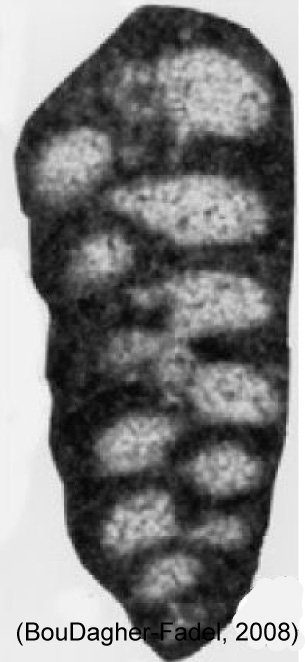 |
Wall agglutinated with calcareous cement, solid imperforate, proloculus succeeded by rectilinear series of chambers, biserially arranged.
Aperture: anteriormarginal, simple basal, narrow slit
Geologic range: Early Jurassic to Cretaceous
|
Superfamily TEXTYULARIODEA
- Test: trochospiral, biseral or triserial in early stages but later may be uniserial or biserial
- Wall: agglutinated, canaliculate
- Geologic range: Early Jurassic to Holocene
Family Chrysalidinidae
- Test: high trocospiral, with quinqueserial, quadriserial, triserial or biserial coiling modes, or with certain consecutive pairs of these.
- Aperture: central along the axis of coiling. In quadriserial or quinqueserial forms, an umbilicus is present and the aperture is covered with a broad umbilical flap, which may be penetrated by multiple accessory apertures.
Subfamly Paravalvulininae
- The subfamily includes all initially quadriserial or quinquesrial forms, becoming quadriserial or quinqueserial in neanic growth and then quinqueserial, quadriserial or triserial in the adult.
- Geologic range: Jurassic
![]() 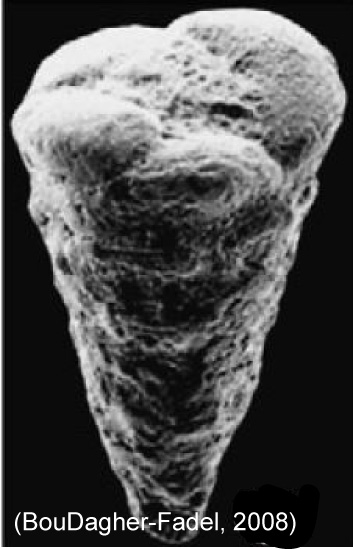 |
Test: adult tests are quadriserial or quinqueserial, cribrate aperture, umbilicus concave with no internal umbilical pillars. Umbilical apertural flaps of successive whorls are broad and are axially separated by a narrow space
Geologic range: Jurassic
|
![]() 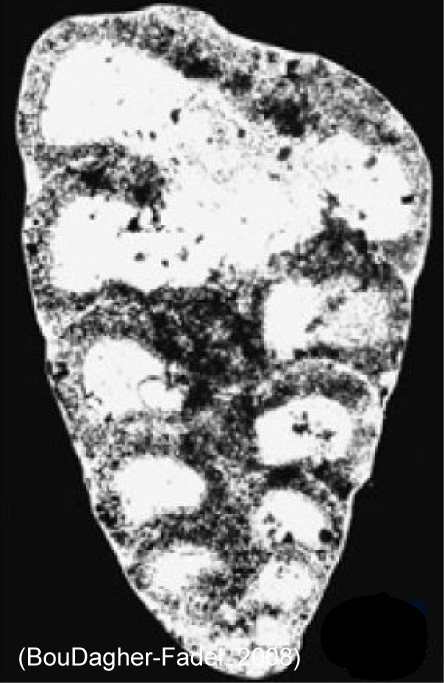 |
Test: quadriserial in the adult form. Umbilicus is concave with no internal umbilical pillars. Apertural flaps of successive whorls are well separated
Septa: flattened with narrow umbilicus
Geologic range: Jurassic
|
![]() 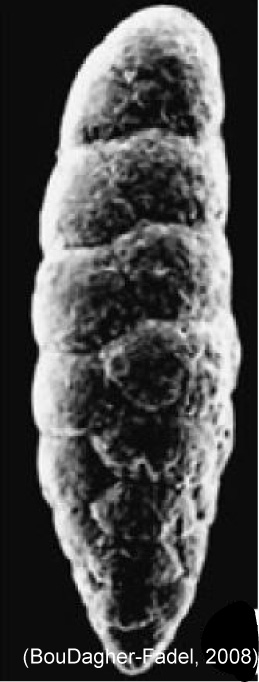 |
Test: Forms with septa and terminal faces that are highly convex. Genus was reassigned to the Family
Chrysalidinidae rather than to the Family Prolixoplectidae (Loeblich and Tappan, 1988).
Geologic range: Jurassic
|
![]()  |
Test: quadriserial in adult with
flattened septa, or with septa and terminal
face concave. Geologic range: Jurassic
|
SUBORDER MILIOLINA
- Test: coiled commonly with two or more chambers arranged in varying planes about the longitudinal axis, later they may become involute. Advanced forms may have secondary partitions within the chambers.
- Geologic range: Late Triassic to Holocene
Family Nautiloculinidae
- Test: free, lenticular, planispiral, and involute with secondary thickening in the umbilical region.
- Aperture: equatorial
- Geologic range: Late Jurassic to Late Cretaceous
![]() 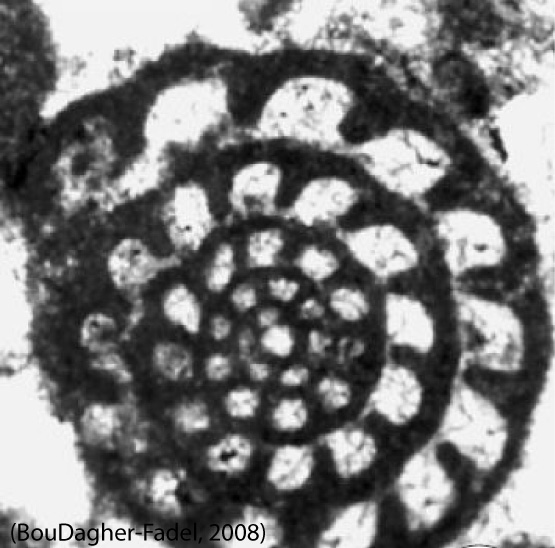 |
Presently, Nautiloculina has been placed systematically in the Milioloidea because some of the miliolines (such as Austrotrillina, Quinqueloculina, etc.) display doublelayered walls like Nautiloculina, although the thin dark layer is internal to the thick transparent layer of the wall of the normal miliolines, but it is external to the wall of Nautiloculina. This classification scheme is under debate.
Test: biumbonate, nautiliform with chambers increasing slowly in height.
Geologic range: Jurassic to Early Cretaceous
|
References
BouDagher-Fadel, M.K., 2008. Evolution and Geological Significance of Larger Benthic Foraminifera. Developments in Paleontology and stratigraphy, v. 21, 540p.